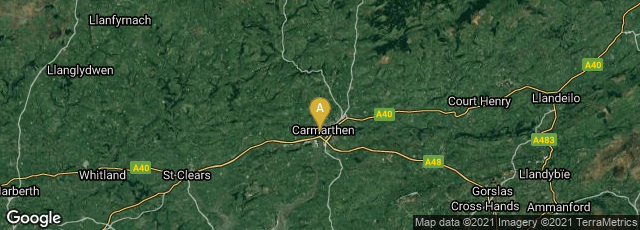

A: Carmarthen, Wales, United Kingdom
One of the collection of manuscripts amassed at the mansion of Hengwrt, near Dolgellau, Gwynedd, Wales, by Welsh antiquary Robert Vaughan in the 17th century, the Black Book of Carmarthen (Llyfr Du Caerfyrddin) may be the earliest surviving manuscript written entirely in Welsh. It was associated with the Priory of St. John the Evangelist and Teulyddog at Carmarthen, possibly the oldest town in Wales. This and its black binding are the source of its name. Notably the manuscript contains some of the earliest references to King Arthur and Merlin.
The Black Book of Carmarthen is a small (170 x 125 mm), incomplete, vellum codex of 54 folios (108 pages) in eight gatherings. Though it was written by a single scribe, inconsistency in the ruling of each folio, in the number of lines per folio, and in handwriting size and style, suggest a non-professional writing over a long period of time. The opening folia, written in a large textura on alternating ruled lines, are followed by folia in much smaller, cramped script.
"The book contains a small group of triads about the horses of Welsh heroes, but is chiefly a collection of 9th–12th century poetry falling into various categories: religious and secular subjects, and odes of praise and of mourning. Of greater interest are the poems which draw on traditions relating to the Welsh heroes associated with the Hen Ogledd (Cumbria and surrounding area), and especially those connected with the legend of Arthur and Myrddin, also known as Merlin, thus predating the descriptions of Merlin by Geoffrey of Monmouth. One of the poems, The Elegy of Gereint son of Erbin, refers to the "Battle of Llongborth", the location of which can no longer be pinpointed, and mentions Arthur's involvement in the battle.
"The poems 'Yr Afallennau' and 'Yr Oianau' describe the mad Merlin in a forest talking to an apple tree and a pig, prophesying the success or failure of the Welsh army in battles with the Normans in South Wales" (Wikipedia article on Black Book of Carmarthen, accessed 04-07-2015).
The manuscript seems to have been first recorded in the 16th century, when it came to the possession of Sir John Prise (Price) of Brecon, a Welsh public notary who acted as a royal agent and visitor of the monasteries during the dissolution of the monasteries by Henry VIII. It was given to him by the treasurer of St. David’s Cathedral, having come from Carmarthen Priory. In the 19th century William Forbes Skene described the Llyfr Du Caerfyrddin as one of the ‘Four Ancient Books of Wales’. It is preserved in the National Library of Wales (NLW Peniarth MS 1).
A digital facsimile of the manuscript is available from the National Library of Wales (Llyfrgell Genedlaethol Cymru) at this link. Note that early black leather binding on the book no longer appears to exist. The original manuscript is now bound in modern black morocco.